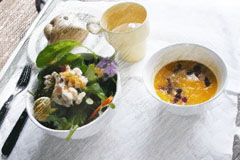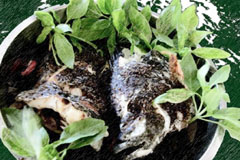Symbiotic Meal
Proper and balanced diet helps to keep physiological activities going as well as maintain health and reduce the chance of getting ill, and diet, broadly speaking, should refer to not only the foods people consume, but also the environment where foods are consumed. Symbiotic meal, as defined by Symbiosphere 1 Center, consists of abundant and assorted fruits and vegetables (which may be eaten cooked or raw, depending on their species), a small amount of meat that is rich in nucleic acid and excellent protein, and together with some carbohydrates. To be truly symbiotic, this kind of meal has to be consumed in a symbiotic environment, in which human activity-rest patterns are diurnal and human consumption of resources is restrained.
 At present, one-third of the plants at Symbiosphere 1 Center can be eaten raw. Since humans need more water-soluble vitamins (such as B vitamins and vitamin C) than fat-soluble vitamins (such as vitamin A, D, E, and K), and that water-soluble vitamins are likely to be destroyed if processed and cooked, the best way to ingest water-soluble vitamins is to eat them raw. Thus, salad made of healthy wild vegetables is an indispensible element of symbiotic meal. In addition, the major source of protein in symbiotic meal is the kind of small fish that are rich in nucleic acid. For now the fish bred at Symbiosphere 1 Center are primarily tilapia and grass carp; meat or internal organs that are rich in nucleic acid, if inadequate, are bought from the market. Also, enjoying symbiotic meal in a symbiotic environment is the key to transform consumed nutrients into immune bases. Unlike fast food in cities, symbiotic meal puts emphasis on the peaceful and joyful mood during meals. It also highlights slow and thorough chewing, which helps to stimulate appetite. Moreover, no less important are verbal exchanges during meals among inhabitants of Symbiosphere 1 Center. These exchanges help inhabitants form consensus on all aspects of life and increase their sense of happiness.
At present, one-third of the plants at Symbiosphere 1 Center can be eaten raw. Since humans need more water-soluble vitamins (such as B vitamins and vitamin C) than fat-soluble vitamins (such as vitamin A, D, E, and K), and that water-soluble vitamins are likely to be destroyed if processed and cooked, the best way to ingest water-soluble vitamins is to eat them raw. Thus, salad made of healthy wild vegetables is an indispensible element of symbiotic meal. In addition, the major source of protein in symbiotic meal is the kind of small fish that are rich in nucleic acid. For now the fish bred at Symbiosphere 1 Center are primarily tilapia and grass carp; meat or internal organs that are rich in nucleic acid, if inadequate, are bought from the market. Also, enjoying symbiotic meal in a symbiotic environment is the key to transform consumed nutrients into immune bases. Unlike fast food in cities, symbiotic meal puts emphasis on the peaceful and joyful mood during meals. It also highlights slow and thorough chewing, which helps to stimulate appetite. Moreover, no less important are verbal exchanges during meals among inhabitants of Symbiosphere 1 Center. These exchanges help inhabitants form consensus on all aspects of life and increase their sense of happiness.
 Symbiotic meal is one of the determining factors that have born on the health of the inhabitants at Symbiosphere 1 Center. Featuring self-cultivated wild vegetables that are prepared in various ways to accommodate inhabitants' individual constitutions, symbiotic meal is meant to realize the prospect of improving health and ensuring longevity.
Symbiotic meal is one of the determining factors that have born on the health of the inhabitants at Symbiosphere 1 Center. Featuring self-cultivated wild vegetables that are prepared in various ways to accommodate inhabitants' individual constitutions, symbiotic meal is meant to realize the prospect of improving health and ensuring longevity.
 At present, one-third of the plants at Symbiosphere 1 Center can be eaten raw. Since humans need more water-soluble vitamins (such as B vitamins and vitamin C) than fat-soluble vitamins (such as vitamin A, D, E, and K), and that water-soluble vitamins are likely to be destroyed if processed and cooked, the best way to ingest water-soluble vitamins is to eat them raw. Thus, salad made of healthy wild vegetables is an indispensible element of symbiotic meal. In addition, the major source of protein in symbiotic meal is the kind of small fish that are rich in nucleic acid. For now the fish bred at Symbiosphere 1 Center are primarily tilapia and grass carp; meat or internal organs that are rich in nucleic acid, if inadequate, are bought from the market. Also, enjoying symbiotic meal in a symbiotic environment is the key to transform consumed nutrients into immune bases. Unlike fast food in cities, symbiotic meal puts emphasis on the peaceful and joyful mood during meals. It also highlights slow and thorough chewing, which helps to stimulate appetite. Moreover, no less important are verbal exchanges during meals among inhabitants of Symbiosphere 1 Center. These exchanges help inhabitants form consensus on all aspects of life and increase their sense of happiness.
At present, one-third of the plants at Symbiosphere 1 Center can be eaten raw. Since humans need more water-soluble vitamins (such as B vitamins and vitamin C) than fat-soluble vitamins (such as vitamin A, D, E, and K), and that water-soluble vitamins are likely to be destroyed if processed and cooked, the best way to ingest water-soluble vitamins is to eat them raw. Thus, salad made of healthy wild vegetables is an indispensible element of symbiotic meal. In addition, the major source of protein in symbiotic meal is the kind of small fish that are rich in nucleic acid. For now the fish bred at Symbiosphere 1 Center are primarily tilapia and grass carp; meat or internal organs that are rich in nucleic acid, if inadequate, are bought from the market. Also, enjoying symbiotic meal in a symbiotic environment is the key to transform consumed nutrients into immune bases. Unlike fast food in cities, symbiotic meal puts emphasis on the peaceful and joyful mood during meals. It also highlights slow and thorough chewing, which helps to stimulate appetite. Moreover, no less important are verbal exchanges during meals among inhabitants of Symbiosphere 1 Center. These exchanges help inhabitants form consensus on all aspects of life and increase their sense of happiness. Symbiotic meal is one of the determining factors that have born on the health of the inhabitants at Symbiosphere 1 Center. Featuring self-cultivated wild vegetables that are prepared in various ways to accommodate inhabitants' individual constitutions, symbiotic meal is meant to realize the prospect of improving health and ensuring longevity.
Symbiotic meal is one of the determining factors that have born on the health of the inhabitants at Symbiosphere 1 Center. Featuring self-cultivated wild vegetables that are prepared in various ways to accommodate inhabitants' individual constitutions, symbiotic meal is meant to realize the prospect of improving health and ensuring longevity.

 Under the conviction and declaration of Archilife Research Foundation, in order to solve environmental issues faced by the mankind and reduce the conflict caused by the mankind fighting for limited environmental...
Under the conviction and declaration of Archilife Research Foundation, in order to solve environmental issues faced by the mankind and reduce the conflict caused by the mankind fighting for limited environmental...